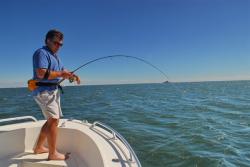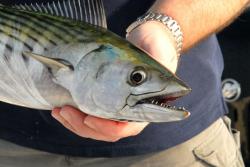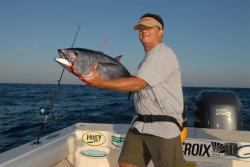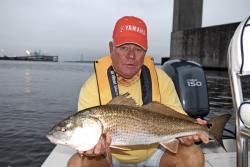Go Light for More Fight
from The Fishing Wire
The Light Line Gamefish Challenge
Catching fish on light tackle requires skill and understanding. It’s also a lot of fun!
Returning to truly light tackle can add to the thrill of catching even medium sized fish.The popularity of thin braided lines has resulted in anglers using line tests that far outstrip the fighting ability of many of the fish they catch. The simple fact that gel-spun braided lines offer all the breaking strength of monofilament, but at a fraction of the diameter, has created a strange trend. Many anglers who used to load a reel with 12-pound test monofilament are now filling it with 30-pound or stronger braid. Why? Because they are about the same diameter so the reel holds about the same amount of either line. For some, being able to use stronger line on smaller outfits is a benefit, but for many species of gamefish it poses a serious question. Does fighting a fish with such strong line require less skill on the part of the angler and, therefore, is it less sporting?
Saltwater fishing is a very diverse pastime and people participate for a variety of reasons. For many, catching a few fish for dinner makes for a great day on the water, while for others, catching and releasing fish on light tackle is the ultimate expression of the sport.
Ocean speedsters provide particular enjoyment on lighter gear.Before the advent of super braids, many anglers used 12-pound test on medium weight outfits when casting for popular inshore gamefish like redfish and striped bass. Fighting a 20- or 30-pound fish on 12-pound test required a deft hand with the tackle. With the advent of high-tech braids, many anglers spooled those same outfits with 30-pound or heavier line. Is that an advantage an accomplished angler really wants? That means the angler is catching the same fish with the same gear, but now the line is as much as three times as strong as the monofilament used before. Making the switch back to light monofilament on some reels and catching a 30-pound striper brought back some of the challenge. It was the difference between using skill and patience to fight a fish that was pulling drag like no tomorrow, and just bending the rod as we reeled it in on stronger line with a heavy drag setting.
“It’s just more fun,” said Tim Surgent, owner of the popular website Stripersonline.com. “Fishing for bottom species like fluke and black sea bass with small bucktails and four- or six-pound test line on ultralight rods and reels not only requires a higher degree of skill to not lose the fish during the fight, it also generates more and frequently larger fish than typical heavier bottom tackle. It’s even more fun using the same outfits for bonito or false albacore.”
Powerful predators headed for the cooler might better justify heavier gear.So just what constitutes light tackle? That varies with the fish you’re chasing. Light tackle for striped bass and redfish might be a medium/light outfit spooled with 10- or 12-pound line, while light for school-size bluefin tuna might be a light action jigging outfit filled with 20- or 30-pound line. You could say a general rule of thumb is to use line that is half the breaking strength of the average weight of the fish you expect to catch. But even that rule is just a generality since the fighting qualities of gamefish vary dramatically from species to species.
Battling fish on light line has been a hallmark of skilled anglers since the introduction of modern fishing reels with drag systems and dependable light lines. Not only does it require quality gear, it takes an understanding of how best to use it and some insight into the fighting abilities of the fish you are chasing. Your technical skills have to be honed, from knot tying to fighting technique, or you will break off a lot more fish than you’ll land. When the line is light, your drag has to be velvet smooth. When dropping down to two- or four-pound test for speedy fish like Spanish mackerel, ladyfish or bonito, even the slightest unevenness in the drag can break the line. Over matching these fish with heavier tackle tends to take the challenge out of catching them.
Light line requires a rod with a softer action to absorb shock, and many light tackle specialists prefer rods that are longer for the same reason. Setting the drag on your reel properly is extremely important because there’s so little room for error. Even with all the right gear and a properly set drag, when it comes time to fight a fish there are techniques that help you best apply what little pressure you’ve brought to the party.
Species like reds, which are frequently released, are particularly good light tackle targets.When you first hook up and the fish takes off, do not lift the rod tip high unless you are fishing in very shallow water where a high angle between the rod and fish will help prevent break-offs on obstacles. Bonefish on the flats require a rod-high fighting stance at times, but in most cases keep the tip low, the rod lightly loaded and pointed in the direction it is running. High sticking doesn’t put any more pressure on the fish than pointing the rod directly at it, and the practice can put you at a disadvantage. By keeping the rod low, you can pick up slack quickly if a fish changes direction or turns toward you. Slack can allow the hook to back out, especially with light line that doesn’t give you much pressure to generate the initial hook set. And speaking of hooks, yours needs to be razor sharp.
If the fish is acrobatic, a slightly different approach comes into play. When the fish runs, keep the rod tip up a little so when it jumps you can dip it quickly to prevent the fish from landing on a tight line and breaking it. If your fish is making a long initial run, it is best to let it pull against the drag and tire. When the run ends, immediately begin gaining back line by lifting the rod and reeling it back down. If you need a little extra drag to budge the fish, now is the time to palm the reel. Cup the bottom of the reel with your cranking hand and gently apply pressure to the base or top rim of the spool. Be very careful. If the fish lunges, drop your fingers away and go back on the reel drag only. If the fish is particularly large and gaining line is difficult, use the boat to pick up line by running slowly in the direction of the fish. The same holds true if a fish’s initial run is so hard and fast that it might strip the reel. The boat can be an important fish fighting tool, part of your arsenal when needed. Most fish are lost on light tackle at the very end of the fight near the boat on a short line. If this is happening to you, try slacking off slightly on the drag setting when it is close, and palm the reel to pull the fish the rest of the way in. If it lunges, controlling the pressure with your fingers is faster than reaching for the drag knob.
The beauty of light tackle fishing is the fish don’t have to be huge to be an awful lot of fun to catch. Match the tackle to the quarry; keep it light and sporty, and you’ll add another dimension to your fishing adventures.



